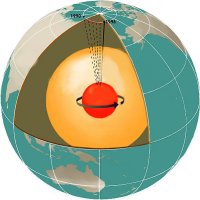
 | Earth's magnetism and the Cambrian explosion. |
The Earth's center consists of a solid iron core which has a radius of about 1220 km (738 miles). Outside this core is a fluid layer composed mostly of molten iron and nickel. The outer core is about 2260 km (1400 miles) across. The inner core is very hot and dense and pushes heat to the outer core. As the Earth spins it creates turbulence in the outer core and the swirling liquid metal creates an electric current hundreds of miles wide.This current in turn creates the Earth’s magnetic field.
It is this magnetic field which protects us from the charged particles of solar winds and exposure to cosmic radiation. (Since the Sun's particles are charged they are repelled by the magnetic field.) So without the magnetic field surrounding the Earth, life on the planet would be rather difficult. The Earth's magnetic field is somewhat unique in our solar system. The only other planet with magnetic fields generated by the movement of liquid metal at the core is Mercury, but Mercury's magnetic field is 100 times weaker than that of the Earth.
But was Earth's magnetic field always so strong? A study published in the 2019 issue of journal Nature Geoscience (ref) suggests that this was not the case. The researchers analyzed samples of plagioclase and clinopyroxene rock from eastern Quebec in Canada. Both pyroxene and plagioclase are silicate minerals which are commonly found in igneous and metamorphic rocks, and these samples are 565 million years old. These rock types are a major constituent mineral in the Earth's crust, and consequently an important diagnostic tool. But for this study the researchers were interested not in the silicates but in tiny magnetic mineral inclusions known as magnetits.
Several studies reported that plagioclase feldspars sometimes contain needle-shaped magnetites with high magnetic stability. Magnetite is a mineral whose primary component is iron oxide that contains equal amounts of Iron(II) and iron (III). As its name implies, it is magnetic. Because magnetic mineral inclusions are isolated from the surrounding environment, they have the potential to preserve an original magnetic signature even in chemically altered sediments.
The analyzed samples in this case contained tiny magnetic needles about 50 to 100 nanometers in size.
"Those tiny magnetic particles are ideal magnetic recorders," said co-author John Tarduno, the chair of the Earth and Environmental Sciences department and a professor at the University of Rochester in New York. "When they cool, they lock in a record of Earth's magnetic field that's maintained for billions of years."
So, by sticking the samples in a magnetometer, the researchers were able to show that the particles' charge was very low. In fact they estimate that 565 million years ago Earth's magnetic field was over 10 times weaker than it is today — the weakest ever documented – before it abruptly regained its power.
In Earth's early years, the core was all liquid. But at some point iron began to cool and solidify in the center of the planet. As the inner core solidified, lighter elements such as silicon, magnesium and oxygen were released into the outer liquid layer of the core, creating a movement of fluid and heat called convection.
Why and how the inner core suddenly started to solidify is still a mystery. But what we know is that from its tiny beginning half a billion years ago it has grown to a moon-sized sphere of solid iron and it is still growing at approximately 1 mm a year. The inner core is the most metallic place on Earth and it has had a major impact on conditions on the surface, not the least of these being saving Earth's magnetic shield.
Another thing which is very intriguing is that at the time when Earth acquired its solid core and stronger magnetic field, it also witnessed a sudden proliferation of complex multicellular life on its surface. This was the Cambrian explosion, when most major animal groups first appear in the fossil record.
"Our research indicates that the formation of the inner core began approximately 550m years ago and that happened just before the Cambrian explosion occurred," said Tarduno.
Whether these two events were indeed cause and effect or were independent events which just happened at the same time is still to be determined. However, the timing is certainly intriguing.
Journal Reference:
| _______________________________ | ||||
| Home | | | Shopping | | | Database |
© Biscuit Software 2004-2019
All rights reserved